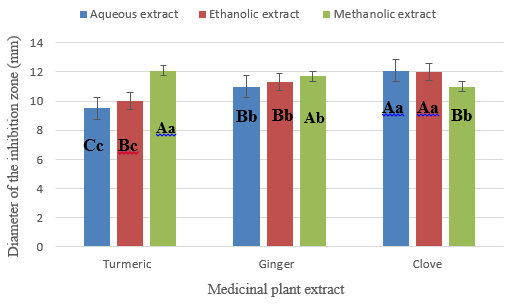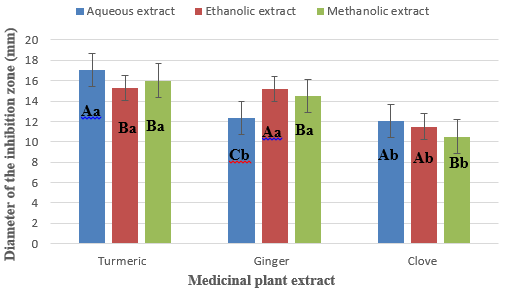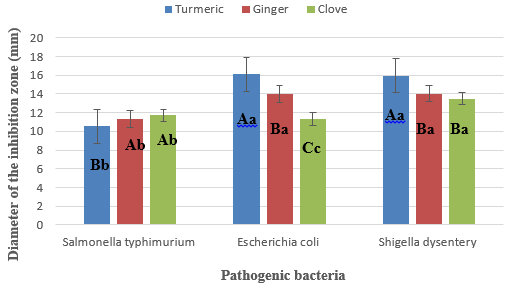MOJ
eISSN: 2381-182X


Research Article Volume 11 Issue 1
1Department of Food Science and Technology, Damghan Branch, Islamic Azad University, Iran
2Agricultural and Natural Resources Research and Education Center of Semnan Province (Shahrood), AREEO, Iran
Correspondence: Ziaolhagh SH, Agricultural Engineering Research Department, Agricultural and Natural Resources Research and Education Center of Semnan Province (Shahrood), AREEO, Shahrood, Iran, Tel +00989123740334
Received: January 10, 2023 | Published: January 23, 2023
Citation: Ebrahimi S, Jalali H, Ziaolhagh SH. Evaluating the antimicrobial effects of turmeric, ginger and clove extracts on some food pathogen. MOJ Food Process Technols. 2023;11(1):21-24. DOI: 10.15406/mojfpt.2023.11.00274
The aim of this study was to investigate the antibacterial effects of hydroalcoholic extracts of turmeric, ginger and clove on food pathogens including Salmonella Typhimurium, Shigella Dysenteriae and E. coli. To determine the antimicrobial effects, certain volumes of hydroalcoholic extracts of turmeric, ginger and clove were added to the blank disks, and after culturing the bacteria in Müller-Hinton Agar culture medium, the disks were placed on the culture medium and after the time required for the growth of the microorganism, the cultures were examined for the diameter of the growth inhibition zone. Among the aqueous extracts, the highest antibacterial effect was related to the aqueous extract of turmeric on Escherichia coli pathogen with an average diameter of the growth inhibition zone of 17 mm and the lowest antibacterial effect was related to the aqueous extract of turmeric versus Salmonella with an average diameter of the growth inhibition zone of 9.5 mm. Among ethanolic extracts, the highest antibacterial effect was related to turmeric and ginger against Escherichia coli and Shigella (average diameter of growth inhibition zone 15.1 mm) and the lowest effect was related to ethanolic extract of turmeric versus Salmonella (mean diameter of growth inhibition zone of 10 mm. Among methanolic extracts, the highest antibacterial effect was related to turmeric methanolic extract versus Shigella (mean diameter of growth inhibition zone of 16.8 mm) and the lowest effect was related to methanolic extract of clove versus Escherichia coli (mean diameter of growth inhibition zone of 10.5 mm). Among the studied pathogens, Salmonella showed the highest sensitivity to the hydroalcoholic extracts of the medicinal plants used, and the highest resistance was obtained for Shigella. Considering that the hydroalcoholic extracts of turmeric, ginger and clove have antimicrobial properties, they can be used as food preservatives against Salmonella, Escherichia and Shigella.
Keywords: antimicrobial, herbal extracts, medicinal plants, natural preservatives, pathogenic bacteria
Foodborne diseases are now a major problem even in developed countries. It is estimated that 6 to 81 million cases of illness and more than 9000 deaths in the United States are caused by pathogens in food.1 Salmonella bacteria have been known to cause intestinal disease for many years and are considered as one of the most important causes of food poisoning.2 Enteropathogenic Escherichia coli is the main cause of children's diarrhea in underdeveloped countries, which is transmitted through contaminated food and water.3 Shigellosis is also one of the most contagious bacterial diarrheas diseases.2 One of the preventive methods to stop the activities of the desired bacteria in foods is the use of antibacterial agents. Among these factors, the use of medicinal plants is expanding, which in addition to having medicinal properties, also have nutritional properties and have antioxidant and antimicrobial effects. Ginger with the scientific name Afficinale Zingiber contains sesquiterpenes, esters, aldehydes, sesquiterpenols and monoterpenes, whose main essential components include zingiberene, arcorcumin and geranyl acetate which make up 1 to 3% of the weight of fresh ginger.4 Clove with the scientific name Eugenia caryophyllus contains many phenolic compounds and its essential oil contains about 80% eugenol and a smaller number of substances such as cupine, caryophyllin, cadinene, caryophyllin oxide, which have antibacterial properties.5,6 Turmeric with the scientific name Curcuma domestica contains curcumin, which has antioxidant and antimicrobial effects.7 The main components of turmeric essential oil include turmerone, zingibrine, germacrone, terpinoline, curcumin and flandrin.8
Studied the antibacterial effects of turmeric, ginger, cloves and cardamom on Helicobacter pylori and showed that aqueous extract of turmeric and alcoholic extract of ginger had the most effect on Helicobacter pylori and ginger, cloves and cardamom were less effective respectively.9 Showed that essential oils of thyme, marjoram and savory were more effective against Escherichia coli, Salmonella typhimurium and Aspergillus niger and Aspergillus flavus than eucalyptus essential oil.10 Lalami et al.11 showed that cinnamon and clove essential oils had an inhibitory effect on Pseudomonas bacteria.11
The inhibitory effects of the essential oils of sage, peppermint and oregano on Listera monocytogenes, Staphylococcus Aureus, Salmonella typhimurium and Escherichia coli;12 Zinyan, lavender and cloves on molds;13 extracts of rosemary, red pepper and turmeric on Staphylococcus aureus, Streptococcus pyogenes;14,15 Cinnamon and ginger on Staphylococcus, Pseudomonas, Escherichia coli, Salmonella, Listeria16,17,18; Aqueous and ethanol extracts of garlic, ginger, cinnamon, turmeric and nutmeg have inhibitory effects on Bacillus subtilis, Escherichia coli, Klebsiella, Salmonella, Shigella, Staphylococcus aureus, Pseudomonas, Staphylococcus epidermidis and Salmonella typhi19–21 have also been demonstrated. Considering that medicinal plants and extracts from these plants can be used to deal with pathogens, the purpose of this research is to investigate the effectiveness of turmeric, ginger and clove extracts on the inactivation of food pathogens (Salmonella typhimurium, Escherichia coli and Shigella dysentery).
Materials
The samples of turmeric, ginger and cloves were prepared from the Research Institute of Medicinal Plants of the Islamic Azad University, Damghan branch, Damghan, Iran. All laboratory materials used in this study were purchased from Merck, Germany. The bacteria used, i.e., Salmonella typhimurium, Shigella dysentery, and enteropathogenic Escherichia coli, were obtained from the Fungi and Bacteria Collection Center of the Scientific and Industrial Research Organization of Iran.
Extraction of plant hydroalcoholic extracts
5 grams of powdered turmeric, ginger and cloves were mixed by an Stewart model shaker with 175 ml of 80% ethanol (1:35 weight/volume ratio), 80% methanol or sterile distilled water (1:35 weight/volume ratio) over a period of 24 hours at ambient temperature. The obtained mixture was filtered with Whatman number one paper until a pure and homogenous extract was obtained, and the filtered extract from this stage was stored at 2-5 degrees Celsius to preserve the effective organic compounds. Then the extracts were placed in a rotary evaporator under vacuum at a temperature of 50 degrees Celsius to completely separate the solvent. Finally, the necessary dilutions (6.25, 12.5, 25 and 50%) were prepared from the concentrated extracts using 10% dimethyl sulfoxide.
Determination of the antimicrobial effects
Disc diffusion method was used to determine antimicrobial effects. For this, blank disks with 2.2, 2.5, 5, 10 mg of extract were used. Sterile blank disks were placed in the intended extracts for 5 minutes so that the extracts were completely absorbed by the disks, then these disks were dried at 37°C. One loop was removed from each and inoculated into the liquid 24 hours before each test. From the 24-hour cultures of bacteria, a microbial suspension equivalent to half of McFarland was prepared and a uniform culture was prepared by swapping on the surface of Mueller Hinton agar culture medium. The desired bacteria, Salmonella typhimurium (ATCC 14028), Shigella dysentery (ATCC 1596) and enteropathogenic Escherichia coli (ATCC 11303) were placed on Mueller Hinton's medium according to the national standard of Iran for the cultivation of each specific bacteria. They were then placed in an incubator at 35-37 degrees Celsius. After 18-24 hours, they were taken out and examined.18
Measuring the diameter of no-growth areas
There is a light area around some discs, which indicates that the bacteria are sensitive to that disc and should be reported as sensitive. In fact, if the diameter of the no-growth area is more than 12 mm, the bacteria is considered sensitive. Also, no light areas are observed around some disks. In this case, the bacteria should be reported as resistant to that disk. If none of the above conditions are observed, then it is reported as semi-sensitive. Based on these explanations, the method of determining the diameter of the no-growth areas was used to measure the antibacterial properties of the hydroalcoholic extracts of turmeric, ginger and cloves against the Salmonella typhimurium, Escherichia coli and Shigella dysentery.
The diameter of no-growth area was measured by a millimeter ruler with three repetitions. The results obtained from three repetitions were reported as an average. The results were analyzed based on a completely randomized design using SPSS16 software.
Antibacterial effect of hydroalcoholic extracts on Salmonella typhimurium
As can be seen in Figure 1, the inhibitory effect of aqueous and ethanolic extracts of cloves on Salmonella was higher than that of turmeric and ginger with the average diameter of the no-growth area of 12.1 and 11.75 mm, respectively. The lowest inhibitory effect of aqueous and ethanolic extracts was related to turmeric with the average diameter of growth area of 9.5 and 10 mm (p<0.05). But in the case of the methanolic extract, the opposite result was observed, which means that the highest inhibitory effect on Salmonella was for the methanolic extract of turmeric with an average diameter of the no-growth area of 12.1 mm, and the lowest inhibitory effect was for the methanolic extract of cloves with an average diameter of the no-growth area of 11 mm was observed (p<0.05).

Figure 1 Antibacterial effect of aqueous, ethanolic and methanolic extracts of turmeric, ginger and cloves on Salmonella. Capital letters show the difference between three types of extracts in each medicinal plant and small letters show the difference between each of the extracts in three types of medicinal plants at the 5% probability level.
Antibacterial effect of hydroalcoholic extracts on Escherichia coli
The obtained results showed the inhibitory power of aqueous, ethanolic and methanolic extracts of turmeric with the average diameter of no-growth area being 17, 15.3 and 16 mm, respectively. As can be seen in Figure 2, the lowest inhibitory effect for all three aqueous, ethanolic and methanolic extracts was for cloves with the average diameter of the no-growth area of 12, 11.5 and 10.5 mm, respectively. Of course, the difference between turmeric and ginger was not significant in the case of ethanolic and methanolic extracts.

Figure 2 Antibacterial effect of aqueous, ethanolic and methanolic extracts of turmeric, ginger and cloves on Escherichia coli.Capital letters show the difference between three types of extracts in each medicinal plant and small letters show the difference between each of the extracts in three types of medicinal plants at the 5% probability level.
Antibacterial effect of hydroalcoholic extracts on Shigella
As can be seen in Figure 3, the highest antibacterial effect against the Shigella dysentery was observed for aqueous, ethanolic and methanolic extracts of turmeric with the average diameter of the no-growth area of 16, 15 and 16.8 mm, respectively. The lowest inhibitory effect was for ethanolic and methanol extracts of cloves and the aqueous extract of ginger extract with the diameter of the no-growth area of 13, 14 and 11.6 mm, respectively.

Figure 3 Antibacterial effect of aqueous, ethanolic and methanolic extracts of turmeric, ginger and cloves on Shigella dysentery. Capital letters show the difference between three types of extracts in each medicinal plant and small letters show the difference between each of the extracts in three types of medicinal plants at the 5% probability level.
Comparing the antibacterial effects of hydroalcoholic extracts on the studied pathogens
As seen in Figure 4, Salmonella typhimurium was more sensitive to hydroalcoholic extracts of turmeric and ginger than Escherichia coli and Shigella dysentery was the most resistant to the extracts of all three plants. The results also showed that in the case of Salmonella Typhimurium, the inhibitory effect of hydroalcoholic extracts of clove and ginger were more than that of turmeric, but in the case of Escherichia coli and Shigella dysentery, the effect of hydroalcoholic extracts of turmeric was more than the other two medicinal plants.

Figure 4 Antibacterial effect of hydroalcoholic extracts of turmeric, ginger and cloves on Salmonella typhimurium, Escherichia coli and Shigella dysentery. The capital letters show the difference between the three types of medicinal plants in the inhibitory effect on each bacterium and the small letters show the difference between the effect of each of the medicinal plants on the three types of bacteria at the 5% probability level.
The results of the present study are consistent with the results of Dehghan et al.9 The results of both indicate the antibacterial effect of turmeric, ginger and cloves on pathogens, the difference between their work and current research was the type of microorganism used also showed that ginger extract had an inhibitory effect on Escherichia coli and Salmonella.22 The results of the current research regarding the antibacterial properties of hydroalcoholic extracts of turmeric, ginger and cloves on the pathogenic Escherichia coli showed that the effectiveness of the extracts varied depending on the type of extract and the plant; In such a way that the most antibacterial effect of aqueous extracts was related to turmeric and the least inhibitory power was related to cloves, so the difference between the two was very large. But regarding the ethanolic extracts, it was observed that the effectiveness of the ethanolic extracts of turmeric and ginger was equal to each other and both were much more effective than the ethanolic extract of cloves. Investigating the antibacterial effect of turmeric was significantly more than that of methanolic extract of cloves, and the middle rank belonged to ginger. Examining the results related to the antibacterial properties of methanolic extracts showed that the hydroalcoholic extracts of turmeric were more effective than the hydroalcoholic extracts of ginger and cloves. Therefore, it can be said that aqueous, ethanolic and methanolic extracts of turmeric had the most antibacterial effect on Escherichia coli, or in other words, the sensitivity of Escherichia coli to hydroalcoholic extracts of turmeric was more than that of other plants. The data obtained from the present study in relation to the antibacterial properties of hydroalcoholic extracts were consistent with the data obtained from the study of Nelson et al.22 Seepersad et al.23 Panpatil et al.20 who investigated the antibacterial effect of turmeric, ginger and garlic on various pathogens also showed that the antibacterial effect of hydroalcoholic extracts of turmeric was more than that of ginger.20 Also, the study conducted indicates the inhibitory effect of three aqueous, ethanolic and methanolic extracts of ginger on Escherichia coli, and the inhibition rate of each was different depending on the type of extract.21
As the obtained results show, the inhibitory power of the hydroalcoholic extracts of medicinal plants studied in this research was different according to the type of extract and the plant in question. What was obtained from the comparison and explanation of the results is that all the extracts had antibacterial properties and the sensitivity of pathogenic bacteria was different according to the type of extract and the type of medicinal plant. This conclusion can be confirmed by comparing the results obtained from the present research with the existing records. All the studies available in the literature focused on investigating the antibacterial and inhibitory effect or the lethality rate of hydroalcoholic extracts of various medicinal plants on various pathogens such as Escherichia coli, Shigella dysentery, Salmonella typhimurium, Bacillus, Klebsiella, etc. They express and confirm the existence of such properties in various medicinal plants such as turmeric, ginger, cloves and cardamom.
The results obtained in the present study showed that the hydroalcoholic extracts obtained from three medicinal plants turmeric, ginger and cloves, contain compounds with antibacterial properties. The degree of effectiveness and inhibition of different hydroalcoholic extracts of different plants differed from each other, which could be caused by the type of microorganism used, and the level of resistance of each of these three microorganisms to the hydroalcoholic extracts of the same plant was different. It could be caused by the type of extract (aqueous, ethanolic and methanolic extract). It can be said that the greater inhibition of alcoholic extracts compared to some aqueous extracts may be attributed to the organic nature of alcohol, which dissolves organic substances better, and the release of active compounds seems to be necessary for antibacterial activity.
The data obtained from the present study showed that the hydroalcoholic extracts of turmeric, ginger and clove may act as inhibitory agents against the pathogenic bacteria Salmonella typhimurium, Escherichia coli and Shigella dysentery. The results showed that the contribution and inhibitory power of each of these extracts was different compared to other extracts, but in general, it was observed that all these extracts had inhibitory properties. The results indicated greater and wider inhibitory power of clove hydroalcoholic extracts against Salmonella typhimurium, and higher power of turmeric hydroalcoholic extracts against Escherichia coli and Shigella dysentery.
None.
The author declares that there are no conflicts of interest.

©2023 Ebrahimi, et al. This is an open access article distributed under the terms of the, which permits unrestricted use, distribution, and build upon your work non-commercially.